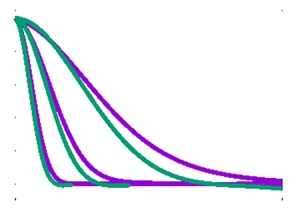Article contents
Correlation function and linear response function of homogeneous isotropic turbulence in the Eulerian and Lagrangian coordinates
Published online by Cambridge University Press: 25 May 2021
Abstract

We study the correlation function and mean linear response function of the velocity Fourier mode of statistically steady-state, homogeneous and isotropic turbulence in Eulerian and Lagrangian coordinates through direct numerical simulation (DNS). As the Lagrangian velocity, we here adopt Kraichnan's Lagrangian-history framework where Lagrangian particles are labelled with current positions and their velocities are measured at some time before. This Lagrangian velocity is numerically calculated with a method known as the passive vector method. Our first goal is to study the relation between the correlation function and the mean linear response function in Eulerian and Lagrangian coordinates. Such a relation is known to be important in analysing the closed set of equations for the two functions, which are obtained by direct-interaction-approximation-type closures. We demonstrate numerically that the fluctuation–dissipation theorem (proportionality between the two functions) does not hold. The relation is further investigated with general analytical expressions of the mean linear response function under stochastic settings, which are known as the fluctuation-response relations in non-equilibrium statistical mechanics. Our second goal is to identify characteristic times associated with the two functions and to compare the times between the Eulerian and Lagrangian coordinates. Our DNS result supports the common view that the Eulerian characteristic times have the sweeping-time scaling ( $\propto k^{-1}$, where
$\propto k^{-1}$, where  $k$ is the wavenumber) for both functions and the Lagrangian characteristic times in the inertial range have the Kolmogorov-time scaling (
$k$ is the wavenumber) for both functions and the Lagrangian characteristic times in the inertial range have the Kolmogorov-time scaling ( $\propto k^{-2/3}$) for both functions.
$\propto k^{-2/3}$) for both functions.
JFM classification
- Type
- JFM Papers
- Information
- Copyright
- © The Author(s), 2021. Published by Cambridge University Press
References
REFERENCES
- 6
- Cited by





